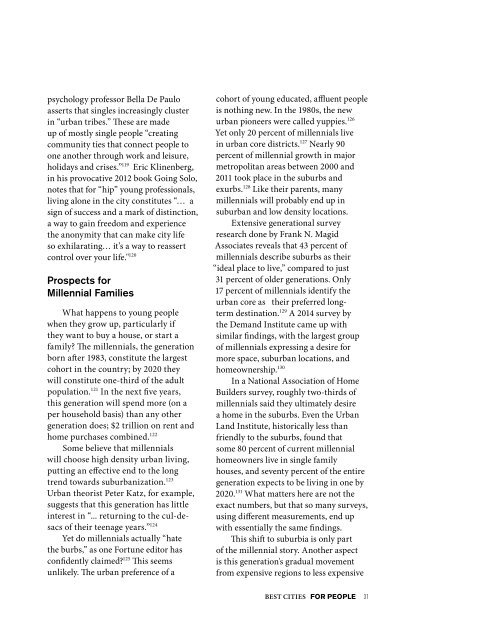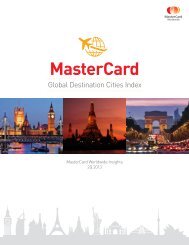FOR PEOPLE
1ONa2xt
1ONa2xt
Create successful ePaper yourself
Turn your PDF publications into a flip-book with our unique Google optimized e-Paper software.
psychology professor Bella De Paulo<br />
asserts that singles increasingly cluster<br />
in “urban tribes.” These are made<br />
up of mostly single people “creating<br />
community ties that connect people to<br />
one another through work and leisure,<br />
holidays and crises.” 119 Eric Klinenberg,<br />
in his provocative 2012 book Going Solo,<br />
notes that for “hip” young professionals,<br />
living alone in the city constitutes “… a<br />
sign of success and a mark of distinction,<br />
a way to gain freedom and experience<br />
the anonymity that can make city life<br />
so exhilarating… it’s a way to reassert<br />
control over your life." 120<br />
Prospects for<br />
Millennial Families<br />
What happens to young people<br />
when they grow up, particularly if<br />
they want to buy a house, or start a<br />
family? The millennials, the generation<br />
born after 1983, constitute the largest<br />
cohort in the country; by 2020 they<br />
will constitute one-third of the adult<br />
population. 121 In the next five years,<br />
this generation will spend more (on a<br />
per household basis) than any other<br />
generation does; $2 trillion on rent and<br />
home purchases combined. 122<br />
Some believe that millennials<br />
will choose high density urban living,<br />
putting an effective end to the long<br />
trend towards suburbanization. 123<br />
Urban theorist Peter Katz, for example,<br />
suggests that this generation has little<br />
interest in “... returning to the cul-desacs<br />
of their teenage years.” 124<br />
Yet do millennials actually “hate<br />
the burbs,” as one Fortune editor has<br />
confidently claimed? 125 This seems<br />
unlikely. The urban preference of a<br />
cohort of young educated, affluent people<br />
is nothing new. In the 1980s, the new<br />
urban pioneers were called yuppies. 126<br />
Yet only 20 percent of millennials live<br />
in urban core districts. 127 Nearly 90<br />
percent of millennial growth in major<br />
metropolitan areas between 2000 and<br />
2011 took place in the suburbs and<br />
exurbs. 128 Like their parents, many<br />
millennials will probably end up in<br />
suburban and low density locations.<br />
Extensive generational survey<br />
research done by Frank N. Magid<br />
Associates reveals that 43 percent of<br />
millennials describe suburbs as their<br />
“ideal place to live,” compared to just<br />
31 percent of older generations. Only<br />
17 percent of millennials identify the<br />
urban core as their preferred longterm<br />
destination. 129 A 2014 survey by<br />
the Demand Institute came up with<br />
similar findings, with the largest group<br />
of millennials expressing a desire for<br />
more space, suburban locations, and<br />
homeownership. 130<br />
In a National Association of Home<br />
Builders survey, roughly two-thirds of<br />
millennials said they ultimately desire<br />
a home in the suburbs. Even the Urban<br />
Land Institute, historically less than<br />
friendly to the suburbs, found that<br />
some 80 percent of current millennial<br />
homeowners live in single family<br />
houses, and seventy percent of the entire<br />
generation expects to be living in one by<br />
2020. 131 What matters here are not the<br />
exact numbers, but that so many surveys,<br />
using different measurements, end up<br />
with essentially the same findings.<br />
This shift to suburbia is only part<br />
of the millennial story. Another aspect<br />
is this generation's gradual movement<br />
from expensive regions to less expensive<br />
BEST CITIES <strong>FOR</strong> <strong>PEOPLE</strong> 31




